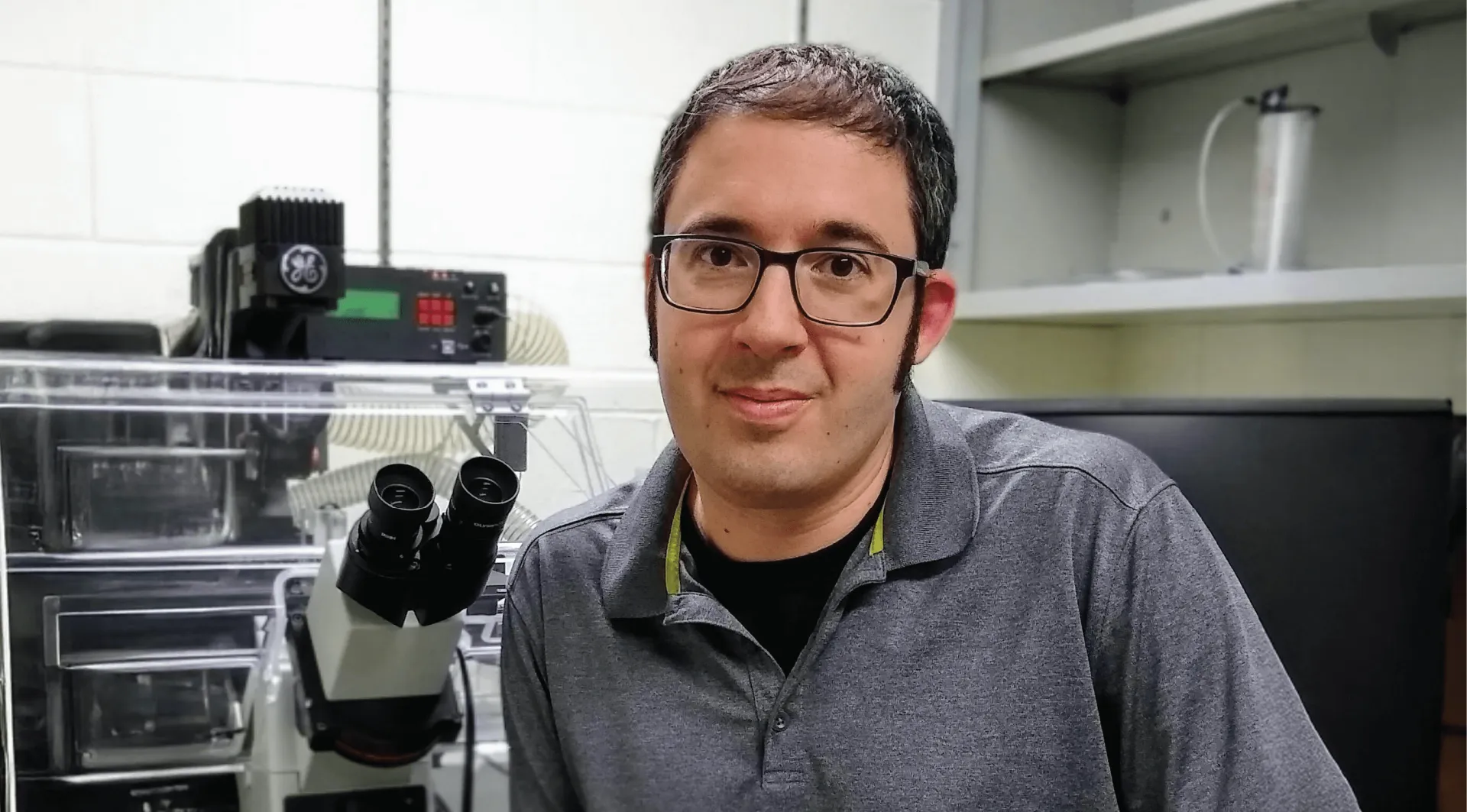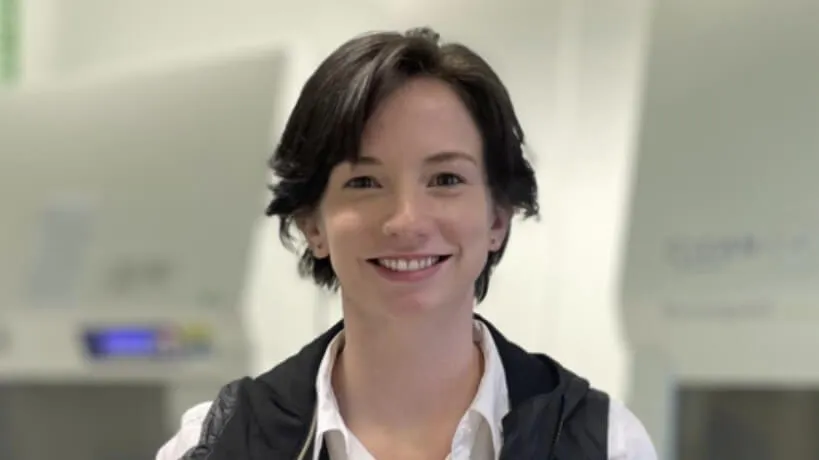The UVM Cancer Center Cancer Host and Environment research program recently welcomed new member, Jeremy Logue, PhD. Dr. Logue, an Associate Professor at Albany Medical College, is a fundamental scientist who studies the molecular mechanisms that govern cell migration, especially in melanoma. Read on to learn more about Dr. Logue’s research and the impact it could have on our communities.
Why did you join the UVM Cancer Center?
I joined the UVM Cancer Center because of its strong commitment to understanding how cancer interacts with the host environment and translating those discoveries to improve outcomes for patients in our region. The Cancer Host and Environment program aligns perfectly with my lab’s focus on how the physical and biochemical properties of tissues influence cancer cell behavior. I was also drawn to the collaborative and interdisciplinary nature of the UVMCC community, which provides an excellent opportunity to connect basic science with clinically relevant problems, particularly those affecting rural populations with high melanoma incidence.
Tell us about your research. What is the biggest takeaway?
My lab studies how cancer and immune cells migrate through the tight, confining spaces found in tissues. We’ve discovered that when cells are physically constrained, they can switch to a completely different migration mode—a phenomenon we call migration plasticity.
Specifically, we focus on how cancer cells switch from a mesenchymal (elongated, adhesion-dependent) mode of migration to an amoeboid (rounded, bleb-based) mode, which we call fast amoeboid (leader bleb-based) migration. This amoeboid form of movement relies on the cell’s mechanical properties and allows it to squeeze through narrow tissue environments with minimal adhesion. Using advanced imaging techniques, optogenetics, and microfluidic devices that mimic tissue confinement, we dissect the key molecular players in this switch, such as the stretch-activated channel Piezo1 and various actin-regulating proteins.
The biggest takeaway from our work is that the ability of cancer cells to change how they move is likely a key factor in how they metastasize and resist therapy. Understanding these mechanisms opens new avenues for targeting metastasis, which remains the leading cause of cancer mortality.
Why cancer research?
Cancer represents one of the most complicated and fascinating biological challenges. My background in cell signaling and cytoskeletal dynamics led me naturally to studying how cancer cells exploit normal physiological processes, such as migration and tissue remodeling, to invade and spread. Cancer research allows me to apply fundamental cell biology to a pressing health issue, and the potential to make discoveries that could ultimately improve patient outcomes is a major motivation for me and my trainees. It also bridges molecular biology, physics, and engineering in ways that continually push us to be innovative.
How does your work directly impact the UVMCC catchment area?
Melanoma incidence in the UVMCC catchment area is among the highest in the country, partly due to factors like outdoor lifestyles and rural demographics. My work on melanoma cell migration directly addresses this regional cancer burden. By uncovering mechanisms that enable melanoma cells to metastasize through confined tissue spaces, such as blood vessels or dense stroma, we aim to identify therapeutic targets that could prevent spread to distant sites like the brain or lungs. This could lead to improved outcomes for patients in the catchment area, where access to specialized care can be a challenge. Additionally, our work provides training opportunities for students and postdocs in the region, helping to strengthen the biomedical research ecosystem that serves these rural communities.
Is there a finding from your research you are particularly proud of?
I'm particularly proud of our discovery that the stretch-activated cation channel Piezo1, through calcium influx, activates the inverted formin-2 (INF2) to drive the mesenchymal-to-amoeboid transition in confined environments. This mechanism allows melanoma cells to adopt a fast, bleb-based migration mode that's highly invasive. It not only explains how cancer cells adapt to mechanical cues in tissues but also highlights Piezo1 and INF2 as potential drug targets to block metastasis.
Do you work with trainees? If so, what do they add to your research?
Absolutely—training the next generation of scientists is one of the most rewarding parts of my job. My lab includes graduate students, medical students, and postdoctoral fellows who bring creativity, technical expertise, and fresh perspectives to every project. For example, current trainees include PhD student Alleah Abrenica, who is studying serotonin signaling in amoeboid melanoma migration, and postdocs like Dr. Anna D’Amico, who is exploring this migration switch in immune escape, and Dr. Neelakshi Kar, who investigates INF2. Their curiosity and dedication challenge assumptions and drive much of our progress.
What is an interesting fact about you or something you’d want people to know?
I'm passionate about scientific imaging and have received honorable mentions in the Nikon Small World "Small World in Motion" competition for videos capturing dynamic cell processes like cancer cell blebbing. Outside the lab, I’ve been a STEM Parent Partner since 2017, organizing hands-on activities for elementary students to spark an early interest in science.
Dr. Logue’s work has been supported by the following grants:
- NIH Maximizing Investigators’ Research Award (R35) – “Molecular Mechanisms of Confined Cell Migration” (2022–2027)
- American Cancer Society Research Scholar Grant – “Cancer Cell Migration and Proliferation in Confined Environments” (2020–2024)
- Melanoma Research Alliance Young Investigator Award – “Examining the Role of Blebs in Melanoma Metastasis” (2020–2023)
You can learn more about his research by reading the below publications:
- Kar N, Caruso AP, Prokopiou N, Abrenica A, & Logue JS (2025). The activation of INF2 by Piezo1/Ca2+ is required for mesenchymal to amoeboid transition in confined environments. Current Biology
- Caruso AP & Logue JS (2024). The biophysics of cell motility through mechanochemically challenging environments. Current Opinion in Cell Biology
- Lavenus SB, Vosatka KW, Caruso AP, Ullo MF, Khan A, & Logue JS (2022). Emerin regulation of nuclear stiffness is required for fast amoeboid migration in confined environments. Journal of Cell Science
- Ullo MF & Logue JS (2021). ADF and cofilin-1 collaborate to promote cortical actin flow and the leader bleb-based migration of confined cells. eLife

